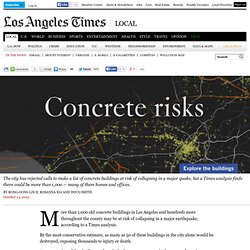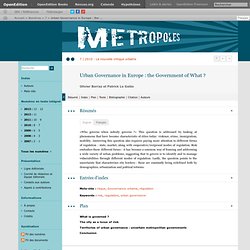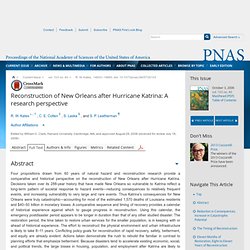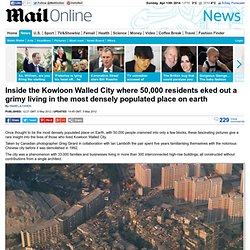

Maps - PreventionWeb.net. Www.preventionweb.net/files/27162_infographic.pdf.
Logra investigadora de la UNAM desalinizar el agua con energía solar — La Jornada. National Collaborating Centre for Methods and Tools. Water scarcity. Securing Your World. Many older L.A. buildings could collapse in an earthquake. Hundreds of old concrete buildings could collapse in a major quake, killing or injuring thousands in L.A.

Officials have known about this for 40 years and have failed to act. The city has rejected calls to make a list of concrete buildings at risk of collapsing in a major quake, but a Times analysis finds there could be more than 1,000 — many of them homes and offices. By Rong-Gong Lin II, Rosanna Xia and Doug Smith October 13, 2013 More than 1,000 old concrete buildings in Los Angeles and hundreds more throughout the county may be at risk of collapsing in a major earthquake, according to a Times analysis. By the most conservative estimate, as many as 50 of these buildings in the city alone would be destroyed, exposing thousands to injury or death. A cross-section of the city lives and works in them: seamstresses in downtown factories, white-collar workers in Ventura Boulevard high-rises and condo dwellers on Millionaires' Mile in Westwood. L.A.’s hidden dangers. Urban Governance in Europe : the Government of What ? 1The paper starts a discussion with the work of our dear friend and colleague Bernard Jouve who died far too early.

For a number of years Bernard critically used European and American debates about governance to develop his own ideas. The paper is an attempt to follow up our debates. 2By contrast to classic views about local government, scholars from various origins have analyzed the political capacity of groups within cities to steer, pilot, change urban society, to adapt to outside pressure, to be transformed by state new policies or by market competition logics (Jouve, Lefèvre, 2003). The urban government/governance debate has proved quite fruitful to contribute to the understanding of the transformation of cities. In the European context, the urban governance/urban regime debate was particularly useful to understand new modes of governance (John, 2001 ; Jouve, 2005) and to contrast different explanatory models of transformation. 6Governments govern: but what exactly ? Urban Governance in Europe : the Government of What ? Wp-content/uploads/2012/06/Homeless-Specific-Disaster-Planning-Sept-2011.pdf.
Onlinelibrary.wiley.com/store/10.1111/j.1468-2427.2012.01111.x/asset/ijur1111.pdf;jsessionid=3F5EF6A510C64DCE3F766DC57E34A7C0.f04t02?v=1&t=ho5v8t3i&s=d60a2a45bbd1a932ed9bcdeb2ef6dabc59d0e72b.
Reconstruction of New Orleans after Hurricane Katrina: A research perspective. Author Affiliations Edited by William C.

Clark, Harvard University, Cambridge, MA, and approved August 29, 2006 (received for review July 18, 2006) Abstract Four propositions drawn from 60 years of natural hazard and reconstruction research provide a comparative and historical perspective on the reconstruction of New Orleans after Hurricane Katrina. Decisions taken over its 288-year history that have made New Orleans so vulnerable to Katrina reflect a long-term pattern of societal response to hazard events—reducing consequences to relatively frequent events, and increasing vulnerability to very large and rare events.
Four propositions drawn from 60 years of research on natural hazards (1–5) and reconstruction after disasters (6) and 288 years of environmental history (7) provide perspective on the vulnerability of the city (parish) of New Orleans to Hurricane Katrina and its prospects for reconstruction. Reduction in Consequences, Increase in Catastrophic Potential Fig. 1. A rare insight into Kowloon Walled City. By Pamela Owen Published: 12:21 GMT, 5 May 2012 | Updated: 14:45 GMT, 5 May 2012 Once thought to be the most densely populated place on Earth, with 50,000 people crammed into only a few blocks, these fascinating pictures give a rare insight into the lives of those who lived Kowloon Walled City.

Taken by Canadian photographer Greg Girard in collaboration with Ian Lamboth the pair spent five years familiarising themselves with the notorious Chinese city before it was demolished in 1992. The city was a phenomenon with 33,000 families and businesses living in more than 300 interconnected high-rise buildings, all constructed without contributions from a single architect. Kowloon Walled City was notorious for drugs and crime but many of its 50,000 residents lived their lives peacefully until it was demolished in the early 90s Canadian photographer Greg Girard and Ian Lambot spent five years getting to know the residents and taking pictures of the densely populated buildings.